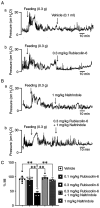Rubiscolin‑6 rapidly suppresses the postprandial motility of the gastric antrum and subsequently increases food intake via δ‑opioid receptors in mice
- PMID: 36111502
- PMCID: PMC9494588
- DOI: 10.3892/mmr.2022.12856
Rubiscolin‑6 rapidly suppresses the postprandial motility of the gastric antrum and subsequently increases food intake via δ‑opioid receptors in mice
Abstract
Rubiscolin‑6 is a food‑derived opioid peptide found in Spinacia oleracea that has anti‑nociceptive, memory‑enhancing, anxiolytic‑like and anti‑depressant effects. Rubiscolin‑6 has been reported to have two opposing effects on food intake. Food intake is closely connected to gut motility; however, to the best of our knowledge, the effect of rubiscolin‑6 on gut motility has not been reported. The present study aimed to investigate the effect of rubiscolin‑6 on postprandial motility of the gastric antrum in conscious mice. A catheter was implanted in the gastric antrum of male C57BL/6J mice. Manometric measurements were performed in fasted male mice and chow was then provided to assess motility in the fed state. Rubiscolin‑6, the δ‑opioid receptor antagonist naltrindole, a mixture of rubiscolin‑6 and naltrindole, or vehicle was administered intraperitoneally 30 min after eating. The percentage motor index (%MI) was then calculated. Cumulative food intake was measured in both ad libitum‑fed and overnight‑fasted mice. The %MI was significantly lower in mice treated with rubiscolin‑6 compared with that in the other groups, but normalized by treatment with the rubiscolin‑6/naltrindole mixture. The decrease in %MI induced by rubiscolin‑6 remained for 1 h after administration. Cumulative food intake was significantly higher 4 and 6 h after rubiscolin‑6 administration in ad libitum‑fed mice but was normalized by the rubiscolin‑6/naltrindole mixture. Food intake 30 min after rubiscolin‑6 administration was normal, but was higher in mice treated with the rubiscolin‑6/naltrindole mixture. Thus, rubiscolin‑6 may have a rapid effect to reduce postprandial antral motility and may subsequently increase food intake after this inhibitory effect disappears. These effects were revealed to be mediated through δ‑opioid receptors. The orexigenic effect of rubiscolin‑6 may be applicable to the treatment of anorexia and cachexia.
Keywords: eating behavior; manometric method; postprandial motility; stomach; δ‑opioid receptor agonist.
Conflict of interest statement
The authors declare that they have no competing interests.
Figures




Similar articles
-
Orally administered rubiscolin-6, a δ opioid peptide derived from Rubisco, stimulates food intake via leptomeningeal lipocallin-type prostaglandin D synthase in mice.Mol Nutr Food Res. 2012 Aug;56(8):1315-23. doi: 10.1002/mnfr.201200155. Epub 2012 Jun 20. Mol Nutr Food Res. 2012. PMID: 22715053
-
New method of manometric measurement of gastroduodenal motility in conscious mice: effects of ghrelin and Y2 depletion.Am J Physiol Gastrointest Liver Physiol. 2009 Nov;297(5):G1028-34. doi: 10.1152/ajpgi.90692.2008. Am J Physiol Gastrointest Liver Physiol. 2009. PMID: 20501433
-
Different endogenous opioid effects on delta- and mu-receptor subtypes in antral and duodenal motility of conscious dogs.Dig Dis Sci. 2002 May;47(5):1027-33. doi: 10.1023/a:1015081822336. Dig Dis Sci. 2002. PMID: 12018898
-
Obestatin inhibits motor activity in the antrum and duodenum in the fed state of conscious rats.Am J Physiol Gastrointest Liver Physiol. 2008 May;294(5):G1210-8. doi: 10.1152/ajpgi.00549.2007. Epub 2008 Mar 6. Am J Physiol Gastrointest Liver Physiol. 2008. PMID: 18325980
-
Delta opioid peptides derived from plant proteins.Curr Pharm Des. 2003;9(16):1325-30. doi: 10.2174/1381612033454838. Curr Pharm Des. 2003. PMID: 12769740 Review.
Cited by
-
Association of OPRD1 Gene Variants with Changes in Body Weight and Psychometric Indicators in Patients with Eating Disorders.J Clin Med. 2024 Sep 1;13(17):5189. doi: 10.3390/jcm13175189. J Clin Med. 2024. PMID: 39274402 Free PMC article.
-
Coexpressed δ-, μ-, and κ-Opioid Receptors Modulate Voltage-Gated Ca2+ Channels in Gastric-Projecting Vagal Afferent Neurons.Mol Pharmacol. 2024 Feb 15;105(3):250-259. doi: 10.1124/molpharm.123.000774. Mol Pharmacol. 2024. PMID: 38182431 Free PMC article.
References
-
- Ellis RJ. The most abundant protein in the world. Trends Biochem Sci. 1979;4:241–244. doi: 10.1016/0968-0004(79)90212-3. - DOI
MeSH terms
Substances
LinkOut - more resources
Full Text Sources

